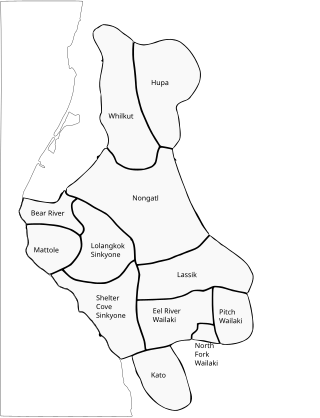Wailaki language
Appearance
(Redirected from Eel River language)
| Wailaki | |
|---|---|
| Eel River | |
| Native to | United States |
| Region | California |
| Ethnicity | Eel River Athapaskans |
| Extinct | 1960s[1] |
| Revival | 2010s[2][3] |
Dené–Yeniseian?
| |
| Dialects |
|
| Language codes | |
| ISO 639-3 | wlk |
qt8 | |
| Glottolog | wail1244 |
| ELP | Eel River Athabaskan |
 Wailaki and other California Athabaskan languages. | |
 Eel River Athabaskan is classified as Extinct by the UNESCO Atlas of the World's Languages in Danger [4] | |
Wailaki, also known as Eel River, is an extinct and revitalizing Athabaskan language spoken by the people of the Round Valley Reservation of northern California, one of four languages belonging to the California Athabaskan cluster of the Pacific Coast Athabaskan languages. Dialect clusters reflect the four Wailaki-speaking peoples, the Sinkyone, Wailaki, Nongatl, and Lassik, of the Eel River confederation. While less documented than Hupa, it is considered to be close to it. It went dormant in the 1960s, but in modern times it is being revived.[3][2]
Phonology
[edit]The sounds in Wailaki:
Consonants
[edit]| Bilabial | Alveolar | Palatal | Velar | Glottal | |||||
|---|---|---|---|---|---|---|---|---|---|
| plain | sibilant | lateral | plain | pal. | |||||
| Nasal | m[a] | n | ŋ | ||||||
| Plosive | plain | p | t | ts[a] | tʃ | k | kʲ | ʔ | |
| aspirated | tʰ | tʃʰ | kʰ | kʲʰ | |||||
| ejective | tʼ | tsʼ | tʃʼ | kʼ | kʲʼ | ||||
| Fricative | s | ɬ | ʃ | ɣ | h | ||||
| Approximant | l | j | w[a] | ||||||
Vowels
[edit]Vowels in Wailaki are /i e a o/, and with length as /iː eː aː oː/.
Grammar
[edit]Wailaki is polysynthetic, meaning that a single word in it is expressed in English as a sentence.[3]
References
[edit]- ^ Wailaki at Ethnologue (19th ed., 2016)

- ^ a b Stansberry, Linda (June 9, 2015). "Welcome Back Wailaki: An Extinct Native Language Rebounds". North Coast Journal. Retrieved 2024-09-08.
- ^ a b c "Reviving the Language – and Culture – of the Wailaki People | Humboldt NOW | Cal Poly Humboldt". now.humboldt.edu. 2017-01-26. Retrieved 2024-08-26.
- ^ Atlas of the World's Languages in Danger (Report) (3rd ed.). UNESCO. 2010. p. 11.
- Goddard, Pliny E. (1923). "Wailaki Texts". International Journal of American Linguistics. 2 (3/4): 77–135. doi:10.1086/463738. JSTOR 1263274. S2CID 224806395.
- Seaburg, William R. (1977). "A Wailaki (Athapaskan) Text with Comparative Notes". International Journal of American Linguistics. 43 (4): 327–332. doi:10.1086/465503. S2CID 144969995.
- Begay, Kayla Rae (2017). Wailaki Grammar (Ph.D. thesis). University of California Berkeley.
